The Artificial Intelligence of Things Sensing System of Real-Time Bridge Scour Monitoring for Early Warning during Floods
Abstract
1. Introduction
2. Scour Monitoring System
2.1. Laboratory Conceptual Validations
2.2. Vibration-Based MEMS Sensor
3. Field Deployment and Results
3.1. Site Description and System Installation
3.2. Mask R-CNN Object Detections and Recognitions
3.3. Scour Monitoring Results and Analysis
4. Scour Depth Simulation for Early Warning
4.1. Hydrodynamic Simulation
4.2. Total Scour-Depth Evolution
5. Conclusions
Author Contributions
Funding
Institutional Review Board Statement
Informed Consent Statement
Acknowledgments
Conflicts of Interest
References
- Wardhana, K.; Hadipriono, F.C. Analysis of recent bridge failures in the United States. J. Perform. Constr. Facil. 2003, 17, 1150. [Google Scholar] [CrossRef]
- Hong, J.H.; Chiew, Y.M.; Lu, J.Y.; Lai, J.S.; Lin, Y.B. Houfeng Bridge failure in Taiwan. J. Hydraul. Eng. 2012, 138, 186–198. [Google Scholar] [CrossRef]
- Chiew, Y.M.; Melville, B.W. Local scour around bridge piers. ASCE J. Hydraul. Eng. 1987, 25, 15–26. [Google Scholar] [CrossRef]
- Melville, B.W.; Chiew, Y.M. Time scale for local scour at bridge piers. ASCE J. Hydraul. Eng. 1999, 125, 59–65. [Google Scholar] [CrossRef]
- Babu, M.R.; Sundar, V.; Rao, S.N. Measurement of scour in cohesive soils around a vertical pile-simplified instrumentation and regression analysis. IEEE J. Ocean. Eng. 2003, 28, 106–116. [Google Scholar] [CrossRef]
- Ballio, F.; Radice, A. A non-touch sensor for local scour measurements. J. Hydraul. Res. 2003, 41, 1814–2079. [Google Scholar] [CrossRef]
- Lin, Y.B.; Chen, J.C.; Chang, K.C.; Chern, J.C.; Lai, J.S. Real-time monitoring of local scour by using fiber Bragg grating sensors. Smart Mater. Struct. 2005, 14, 664–670. [Google Scholar] [CrossRef]
- Lin, Y.B.; Lai, J.S.; Chang, K.C.; Li, L.S. Flood scour monitoring system using fiber Bragg grating sensors. Smart Mater. Struct. 2006, 15, 1950–1959. [Google Scholar] [CrossRef]
- Zhou, Z.; Huang, M.; Huang, L.; Ou, J.; Chen, G. An optical fiber Bragg grating sensing system for scour monitoring. Adv. Struct. Eng. 2011, 14, 67–78. [Google Scholar] [CrossRef]
- Zarafshan, A.; Iranmanesh, A.; Ansari, F. Vibration-based method and sensor for monitoring of bridge scour. J. Bridge Eng. 2012, 17, 829–838. [Google Scholar] [CrossRef]
- Xiong, W.; Cai, C.S.; Kong, X. Instrumentation design for bridge scour monitoring using fiber Bragg grating sensors. Appl. Opt. 2012, 51, 547–557. [Google Scholar] [CrossRef]
- Manzoni, S.; Crotti, G.; Ballio, F.; Cigada, A.; Inzoli, F.; Colombo, E. Bless: A fiber optic sedimeter. Flow Meas. Instrum. 2011, 22, 447–455. [Google Scholar] [CrossRef]
- Ye, X.W.; Su, Y.H.; Xi, P.S. Statistical analysis of stress signals from bridge monitoring by FBG System. Sensors 2018, 18, 491. [Google Scholar]
- Kong, X.; Ho, S.C.; Song, G.; Cai, C.S. Scour monitoring system using fiber Bragg grating sensors and water-swellable polymers. J. Bridge Eng. 2017, 22, 04017029. [Google Scholar] [CrossRef]
- Kong, X.; Cai, C.S.; Hu, J.X.; Xiong, W.; Peng, H. Field application of an innovative bridge scour monitoring system with fiber Bragg grating sensors. J. Aerosp. Eng. 2017, 30, B4016008. [Google Scholar] [CrossRef]
- Lin, Y.B.; Lai, J.S.; Chang, K.C.; Chang, W.Y.; Lee, F.Z.; Tan, Y.C. Using MEMS sensors in the bridge scour monitoring system. J. Chin. Inst. Eng. 2010, 33, 25–35. [Google Scholar] [CrossRef]
- Invernizzi, S.; Lacidogna, G.; Manuello, A.; Carpinteri, A. AE monitoring and numerical simulation of a two-span model masonry arch bridge subjected to pier scour. Strain 2011, 47, 158–169. [Google Scholar] [CrossRef]
- Lin, Y.B.; Lin, T.K.; Chang, C.C.; Huang, C.W.; Chen, B.T.; Lai, J.S.; Chang, K.C. Visible light communication system for offshore wind turbine foundation scour early warning monitoring. Water 2019, 11, 1486. [Google Scholar] [CrossRef]
- Zheng, W.; Yu, W. Probabilistic approach to assessing scoured bridge performance and associated uncertainties based on vibration measurements. J. Bridge Eng. 2015, 20, 04014089. [Google Scholar] [CrossRef]
- Bao, T.; Liu, Z. Vibration-based bridge scour detection: A review. Struct. Control. Health Monit. 2017, 24, e1937. [Google Scholar] [CrossRef]
- Wang, G.; Liang, D.; Yan, J. A vibration-based method for the measurement of subgrade soil scaling factor. Photonic Sens. 2018, 8, 375–383. [Google Scholar] [CrossRef]
- Rashidyan, S.; Ng, T.; Maji, A. Estimating the depth of concrete pier wall bridge foundations using nondestructive sonic echo. J. Nondestruct. Eval. 2017, 36, 56. [Google Scholar] [CrossRef]
- Yu, X.; Zhang, B.; Tao, J.; Yu, X. A new time-domain reflectometry bridge scour sensor. Struct. Health Monit. Int. J. 2013, 12, 99–113. [Google Scholar] [CrossRef]
- Gao, Q.; Yu, X. Design and evaluation of a high sensitivity spiral TDR scour sensor. Smart Mater. Struct. 2015, 24, 085005. [Google Scholar] [CrossRef]
- Lin, C.P.; Wang, K.; Chung, C.C.; Weng, Y.W. New types of time domain reflectometry sensing waveguides for bridge scour monitoring. Smart Mater. Struct. 2017, 26, 075014. [Google Scholar] [CrossRef]
- Miyata, S.; Fujita, M. Laboratory based continuous bedload monitoring in a model retention basin: Application of time domain reflectometry. Earth Surf. Process. Landf. 2018, 43, 2022–2030. [Google Scholar] [CrossRef]
- Maroni, A.; Tubaldi, E.; Ferguson, N.; Tarantino, A.; McDonald, H.; Zonta, D. Electromagnetic sensors for underwater scour monitoring. Sensors 2020, 20, 4096. [Google Scholar] [CrossRef] [PubMed]
- Wang, K.; Lin, C.P.; Jheng, W.H. A new TDR-based sensing cable for improving performance of bridge scour monitoring. Sensors 2020, 20, 6665. [Google Scholar] [CrossRef] [PubMed]
- Wang, K.; Lin, C.P. Applicability and limitations of time domain reflectometry bridge scour monitoring system in general field conditions. Struct. Health Monit. 2020, 20, 1074–1089. [Google Scholar] [CrossRef]
- Funderburk, M.L.; Park, Y.; Netchaev, A.; Loh, K.J. Piezoelectric rod sensors for scour detection and vortex-induced vibration monitoring. Struct. Health Monit. 2021, 20, 1–15. [Google Scholar]
- Wang, C.Y.; Wang, H.L.; Ho, C.C. A piezoelectric film type scour monitoring system for bridge pier. Adv. Struct. Eng. 2012, 15, 897–905. [Google Scholar] [CrossRef]
- Ding, Y.; Yan, T.; Yao, Q.; Dong, X.; Wang, X. A new type of temperature-based sensor for monitoring of bridge scour. Measurement 2016, 78, 245–252. [Google Scholar] [CrossRef]
- Chen, Y.; Tang, F.; Li, Z.; Chen, G.; Tang, Y. Bridge scour monitoring using smart rocks based on magnetic field interference. Smart Mater. Struct. 2018, 27, 085012. [Google Scholar] [CrossRef]
- An, H.; Yao, W.; Cheng, L.; Draper, S.; Zhao, M.; Tang, G.; Zhang, Y.; Hortin, P. Detecting local scour using contact image sensors. ASCE J. Hydraul. Eng. 2017, 143, 04016100. [Google Scholar] [CrossRef]
- Alavi, A.H.; Hasni, H.; Lajnef, N.; Chatti, K.; Faridazar, F. An intelligent structural damage detection approach based on self-powered wireless sensor data. Autom. Constr. 2016, 62, 24–44. [Google Scholar] [CrossRef]
- Lin, T.K.; Wu, R.T.; Chang, K.C.; Chang, Y.S. Evaluation of bridge instability caused by dynamic scour based on fractal theory. Smart Mater. Struct. 2013, 22, 075003-13. [Google Scholar] [CrossRef]
- Bao, T.R.; Swartz, A.; Vitton, S.; Sun, Y.; Zhang, C.; Liu, Z. Critical insights for advanced bridge scour detection using the natural frequency. J. Sound Vib. 2017, 386, 116–133. [Google Scholar] [CrossRef]
- Prendergast, L.J.; Gavin, K. A review of bridge scour monitoring techniques. J. Rock Mech. Geotech. Eng. 2014, 6, 138–149. [Google Scholar] [CrossRef]
- Chen, X.; Niu, X.; Xu, Q.; Qiu, Z.; Lu, G.; Xie, A. Method for monitoring scour depth of pile foundations based on modal identification. Smart Mater. Struct. 2021, 30, 075008. [Google Scholar] [CrossRef]
- Boujia, N.; Schmidt, F.; Chevalier, C.; Siegert, D.; Pham Van Bang, D. Effect of scour on the natural frequency responses of bridge piers: Development of a scour depth sensor. Sensors 2019, 4, 21. [Google Scholar] [CrossRef]
- Fitzgerald, P.C.; Malekjafarian, A.; Bhowmik, B.; Prendergast, L.J.; Cahill, P.; Kim, C.W.; Hazra, B.; Pakrashi, V.; Obrien, E.J. Scour damage detection and structural health monitoring of a laboratory-scaled bridge using a vibration energy harvesting device. Sensors 2019, 19, 2572. [Google Scholar] [CrossRef]
- Yousefpour, N.; Downie, S.; Walker, S.; Perkins, N.; Dikanski, H. Machine learning solutions for bridge scour forecast based on monitoring data. Transp. Res. Rec. 2021, 2675, 1–19. [Google Scholar]
- Maroni, A.; Tubaldi, E.; Val, D.V.; McDonald, H.; Zonta, D. Using Bayesian networks for the assessment of underwater scour for road and railway bridges. Struct. Health Monit. 2020, 19, 1–15. [Google Scholar] [CrossRef]
- Pak, M.; Kim, S. A review of deep learning in image recognition. In Proceedings of the 4th International Conference on Computer Applications and Information Processing Technology (CAIPT), Kuta Bali, Indonesia, 8–10 August 2017; pp. 1–3. [Google Scholar]
- Abiodun, O.I.; Jantan, A.; Omolara, A.E.; Dada, K.V.; Mohamed, N.A.; Arshad, H. State-of-the-art in artificial neural network applications: A survey. Heliyon 2018, 4, 11. [Google Scholar] [CrossRef] [PubMed]
- Lu, H.; Li, Y.; Chen, M.; Kim, H.; Serikawa, S. Brain intelligence: Go beyond artificial intelligence. Mob. Netw. Appl. 2018, 23, 368–375. [Google Scholar] [CrossRef]
- Saravi, S.; Kalawsky, R.; Joannou, D.; Casado, M.R.; Fu, G.; Meng, F. Use of artificial intelligence to improve resilience and preparedness against adverse flood events. Water 2019, 11, 973. [Google Scholar] [CrossRef]
- Sun, W.; Bocchini, P.; Davison, B.D. Applications of artificial intelligence for disaster management. Nat. Hazards 2020, 103, 2631–2689. [Google Scholar] [CrossRef]
- Baek, S.; Pyo, J.; Chun, J.A. Prediction of Water Level and Water Quality Using a CNN-LSTM Combined Deep Learning Approach. Water 2020, 12, 3399. [Google Scholar] [CrossRef]
- Pan, M.; Zhou, H.; Cao, J.; Liu, Y.; Hao, J.; Li, S.; Chen, C.-H. Water level prediction model based on GRU and CNN. IEEE Access 2020, 8, 60090–60100. [Google Scholar] [CrossRef]
- Lai, Y.G. A two-dimensional depth-averaged sediment transport mobile-bed model with polygonal meshes. Water 2020, 12, 1032. [Google Scholar] [CrossRef]
- Lo, S.W.; Wu, J.H.; Lin, F.P.; Hsu, C.H. Cyber surveillance for flood disasters. Sensors 2015, 15, 2369–2387. [Google Scholar] [CrossRef]
- Lo, S.W.; Wu, J.H.; Lin, F.P.; Hsu, C.H. Visual sensing for urban flood monitoring. Sensors 2015, 15, 20006–20029. [Google Scholar] [CrossRef] [PubMed]
- Russakovsky, O.; Deng, J.; Su, H.; Krause, J.; Satheesh, S.; Ma, S.; Huang, Z.; Karpathy, A.; Khosla, A.; Bernstein, M.; et al. ImageNet large scale visual recognition challenge. Int. J. Comput. Vis. 2015, 115, 211–252. [Google Scholar] [CrossRef]
- Krizhevsky, A.; Sutskever, I.; Hinton, G.E. Imagenet classification with deep convolutional neural networks. Adv. Neural Inf. Process. Syst. 2012, 25, 1097–1105. [Google Scholar] [CrossRef]
- Girshick, R.; Donahue, J.; Darrell, T.; Malik, J. Rich feature hierarchies for accurate object detection and semantic segmentation. In Proceedings of the IEEE Conference on Computer Vision and Pattern Recognition, Columbus, OH, USA, 23–28 June 2014; pp. 580–587. [Google Scholar]
- Girshick, R. Fast r-cnn. In Proceedings of the IEEE International Conference on Computer Vision, Santiago, Chile, 7–12 December 2015; pp. 1440–1448. [Google Scholar]
- Ren, S.; He, K.; Girshick, R.; Sun, J. Faster R-CNN: Towards real-time object detection with region proposal networks. IEEE Trans. Pattern Anal. Mach. Intell. 2016, 39, 1137–1149. [Google Scholar] [CrossRef] [PubMed]
- A Large-Scale Object Detection, Segmentation, and Captioning Dataset. Available online: https://cocodataset.org/ (accessed on 15 June 2020).
- He, K.; Gkioxari, G.; Dollár, P.; Girshick, R. Mask r-cnn. In Proceedings of the IEEE International Conference on Computer Vision, Venice, Italy, 22–29 October 2017; pp. 2980–2988. [Google Scholar]
- Morera, Á.; Sánchez, Á.; Moreno, A.B.; Sappa, Á.D.; Vélez, J.F. SSD vs. YOLO for detection of outdoor urban advertising panels under multiple variabilities. Sensors 2020, 20, 4587. [Google Scholar] [CrossRef]
- Jia, W.; Tian, Y.; Luo, R.; Zhang, Z.; Lian, J.; Zheng, Y. Detection and segmentation of overlapped fruits based on optimized Mask R-CNN application in apple harvesting robot. Comput. Electron. Agric. 2020, 172, 105380. [Google Scholar] [CrossRef]
- Nie, X.; Duan, M.; Ding, H.; Hu, B.; Wong, E.K. Attention mask r-cnn for ship detection and segmentation from remote sensing images. IEEE Access 2020, 8, 9325–9334. [Google Scholar] [CrossRef]
- Xu, B.; Wang, W.; Falzon, G.; Kwan, P.; Guo, L.; Chen, G.; Tait, A.; Schneider, D. Automated cattle counting using Mask R-CNN in quadcopter vision system. Comput. Electron. Agric. 2020, 171, 105300. [Google Scholar] [CrossRef]
- Sarp, S.; Kuzlu, M.; Cetin, M.; Sazara, C.; Guler, O. Detecting floodwater on roadways from image data using Mask-R-CNN. In Proceedings of the International Conference on Innovations in Intelligent SysTems and Applications (INISTA), Novi Sad, Serbia, 24–26 August 2020; pp. 1–6. [Google Scholar]
- Huang, J.; Kang, J.; Wang, H.; Wang, Z.; Qiu, T. A novel approach to measuring urban waterlogging depth from images based on mask region-based convolutional neural network. Sustainability 2020, 12, 2149. [Google Scholar] [CrossRef]
- Chaudhary, P.; D’Aronco, S.; Moy de Vitry, M.; Leitão, J.P.; Wegner, J.D. Flood-water level estimation from social media images. In ISPRS Annals of the Photogrammetry, Remote Sensing and Spatial Information Sciences; Copernicus Publications: Enschede, The Netherlands, 2019; Volume 4, pp. 5–12. [Google Scholar]
- Hong, J.H.; Guo, W.D.; Chiew, Y.M.; Chen, C.H. A new practical method to simulate flood-induced bridge pier scour—A case study of Mingchu bridge piers on the Cho-Shui river. Water 2016, 8, 238. [Google Scholar] [CrossRef]
- Laursen, E.M. The total sediment load of streams. J. Hydraul. Div. 1958, 84, 1–36. [Google Scholar] [CrossRef]
- Shen, H.W.; Schneider, V.R.; Karaki, S.S. Local scour around bridge piers. J. Hydraul. Div. 1969, 95, 1919–1940. [Google Scholar] [CrossRef]
- Jain, S.C.; Fischer, E.E. Scour around bridge piers at high velocity. J. Hydraul. Eng. 1980, 106, 1827–1842. [Google Scholar]
- Froehlich, D.C. Analysis of onsite measurements of scour at piers. In Proceedings of the Hydraulic Engineering: Proceedings of the 1988 National Conference on Hydraulic Engineering, Colorado Springs, CO, USA, 8–12 August 1988; pp. 534–539. [Google Scholar]
- Parker, G. Surface-based bedload transport relation for gravel rivers. J. Hydraul. Res. 1990, 28, 417–436. [Google Scholar] [CrossRef]
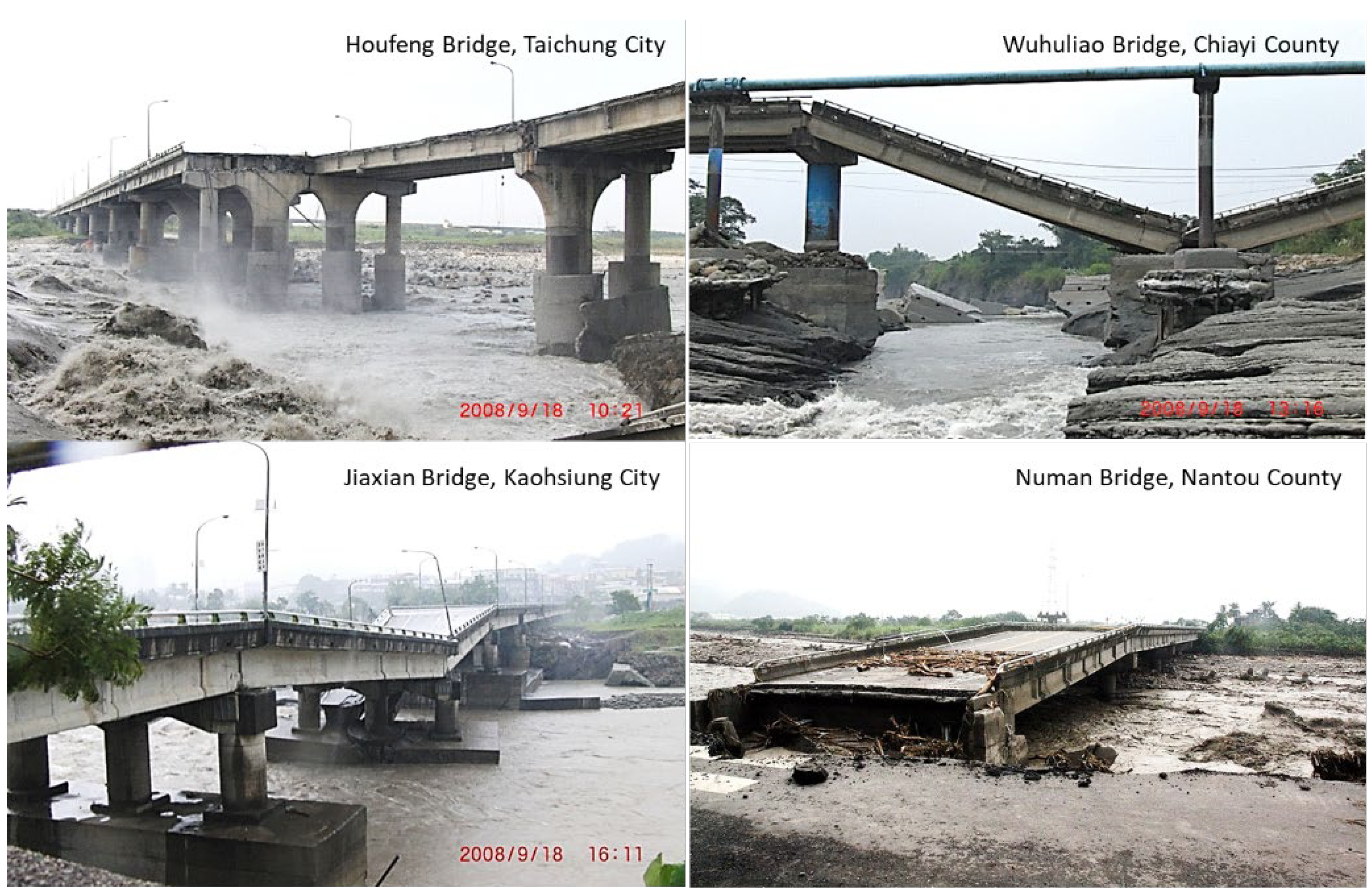
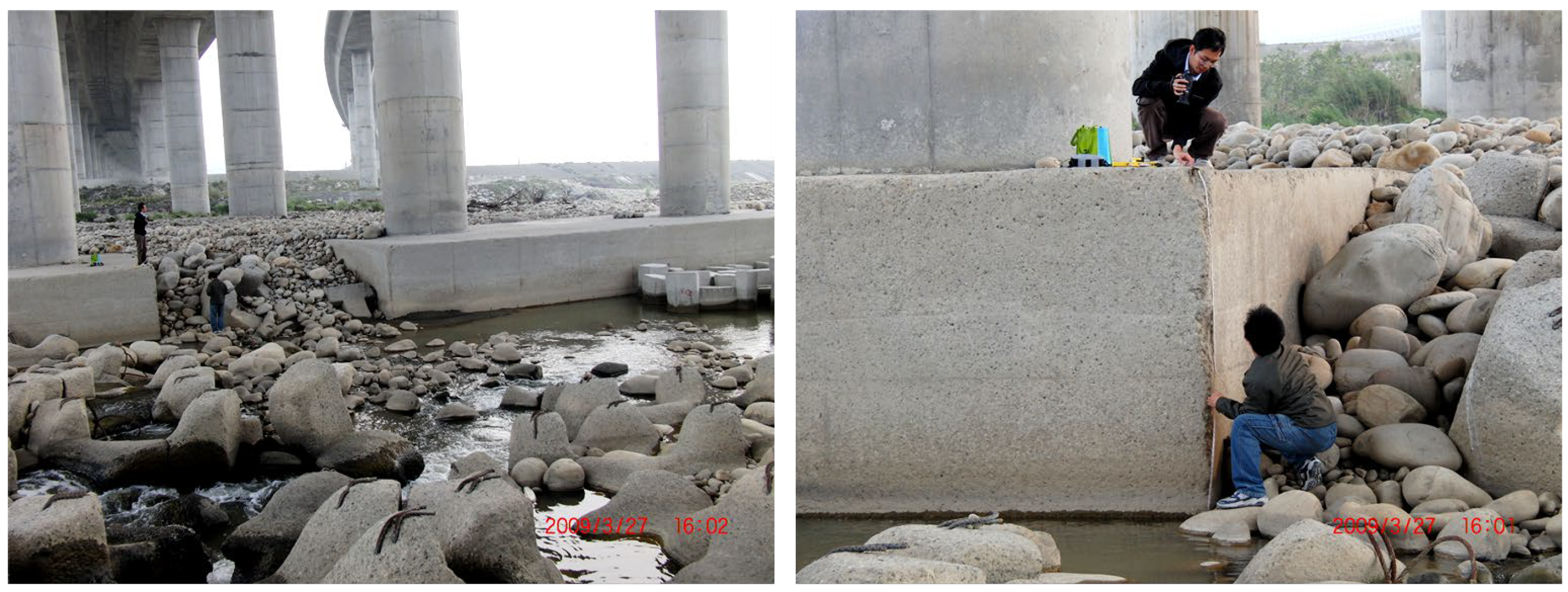

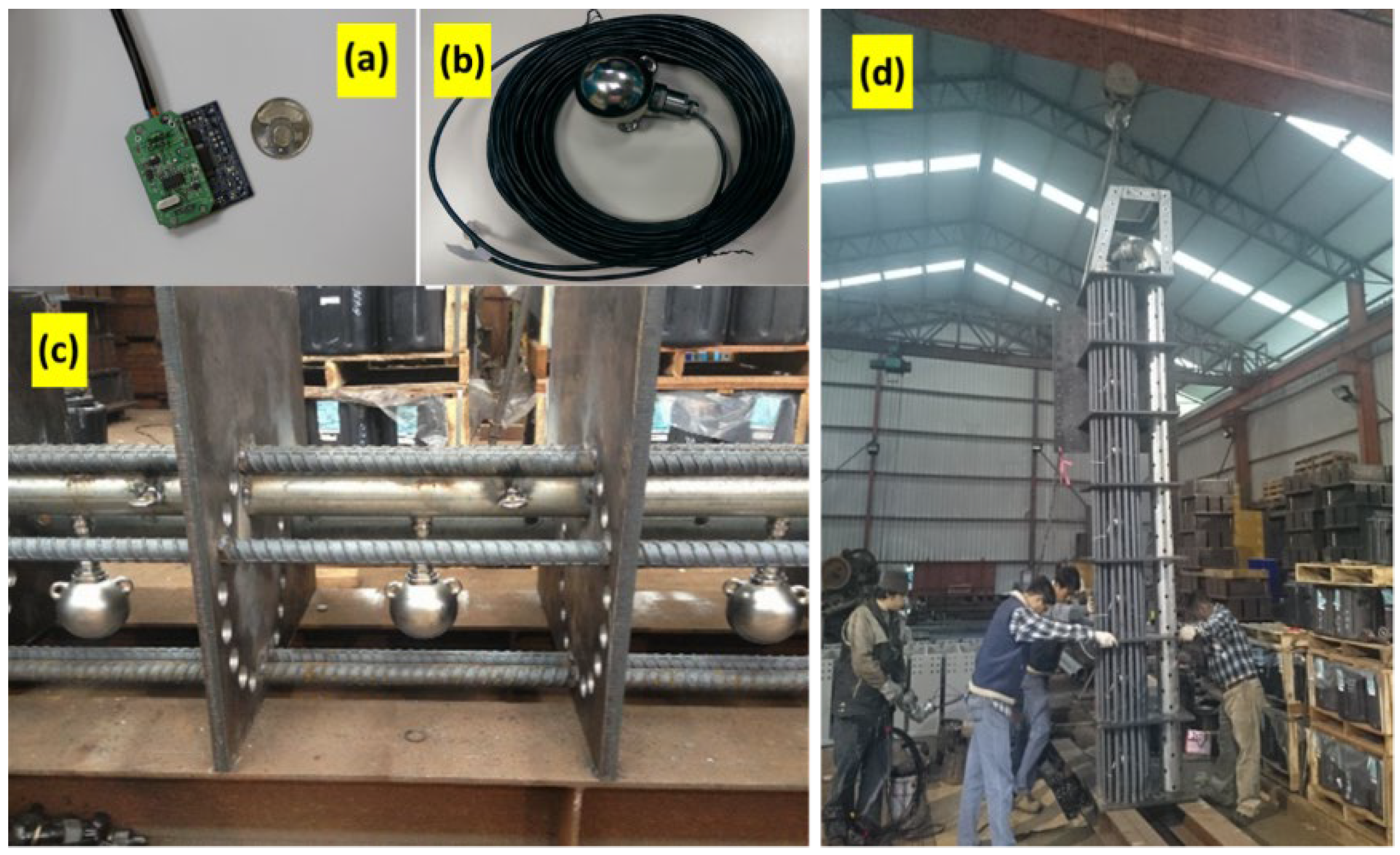
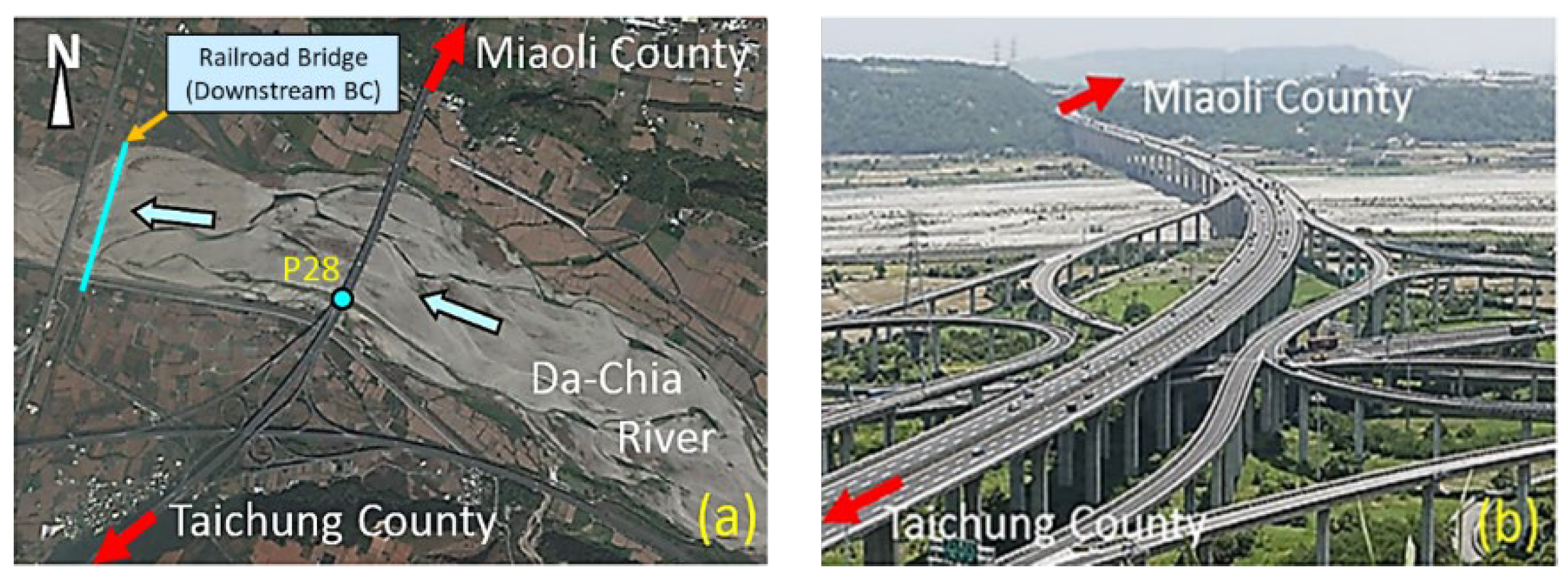
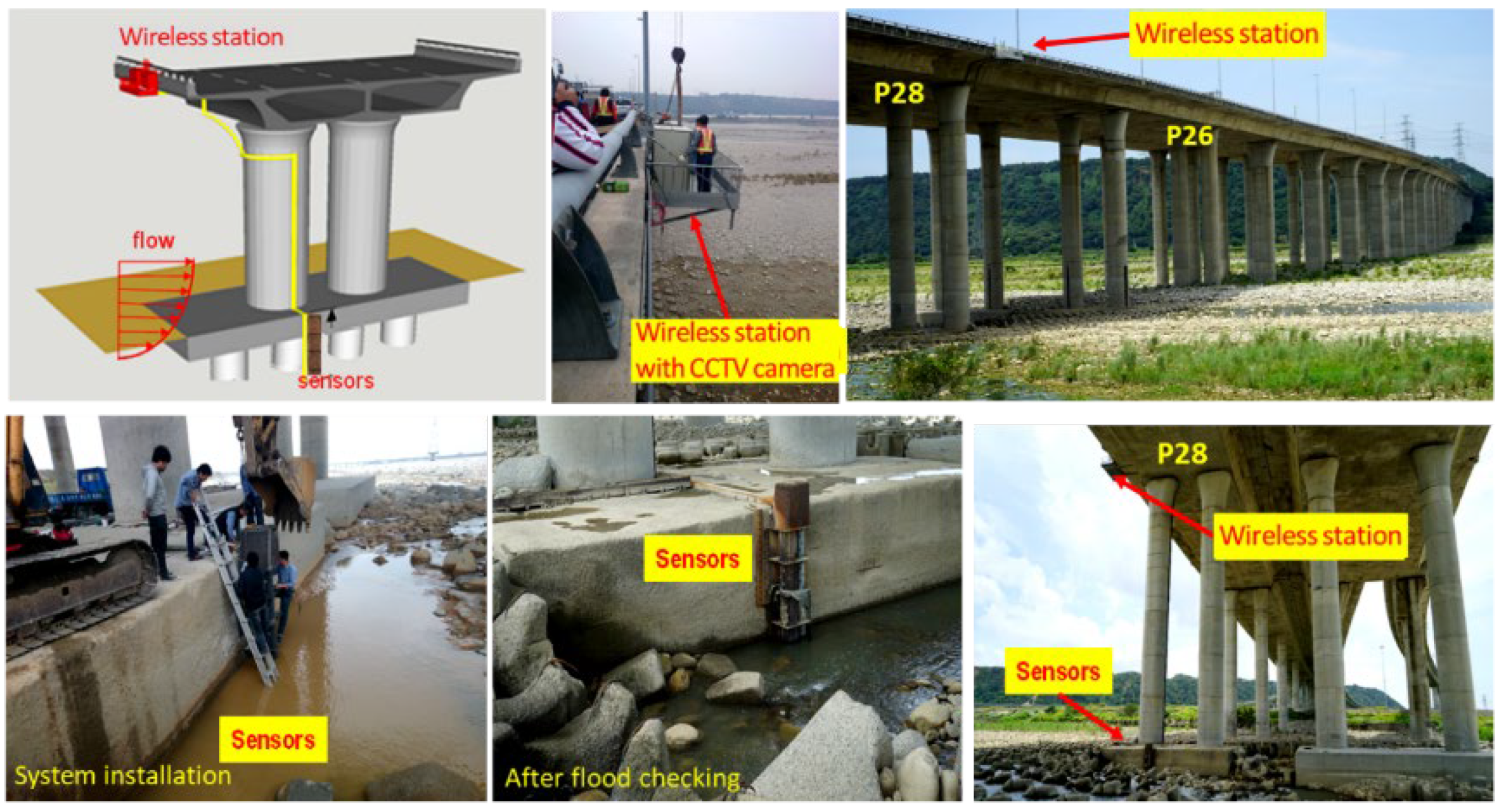
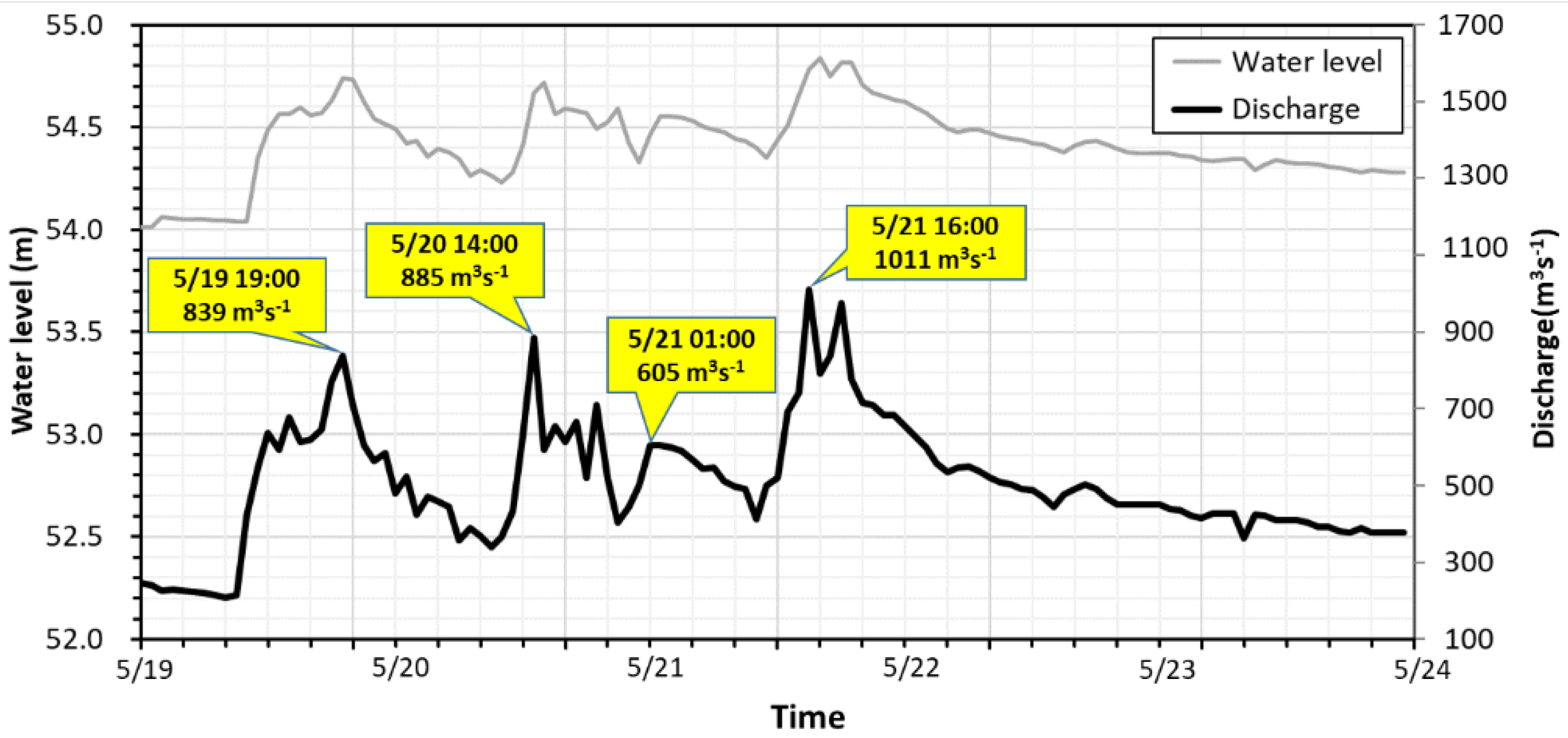

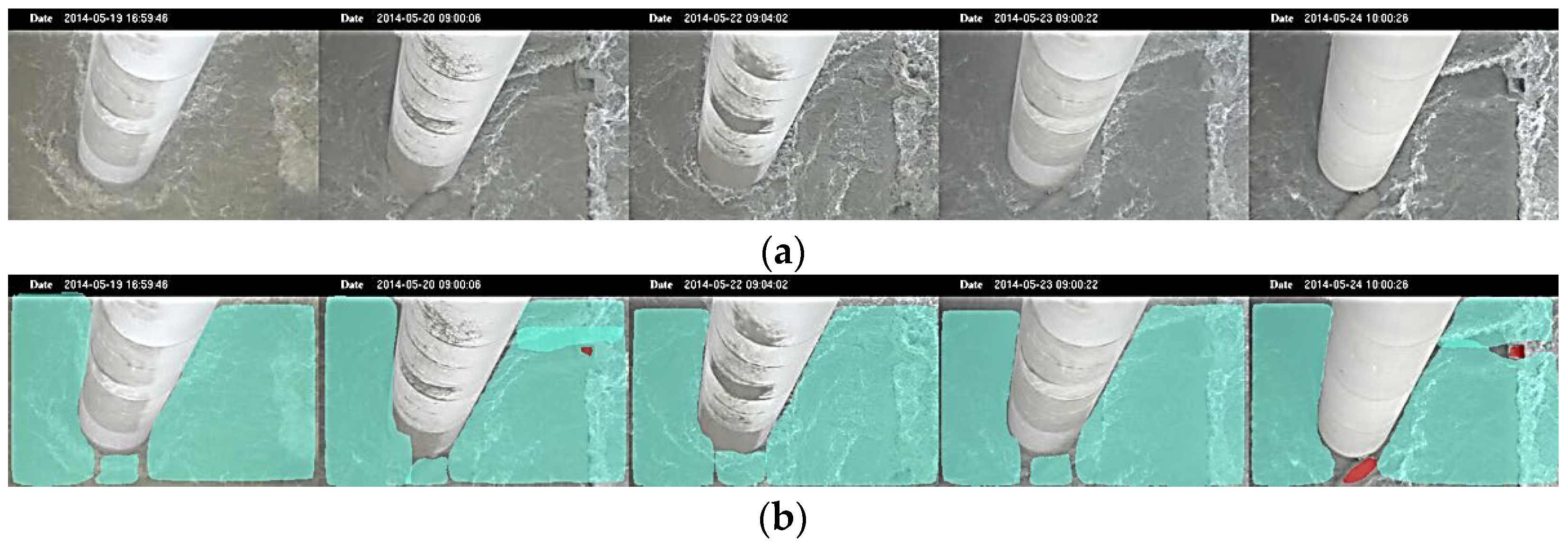
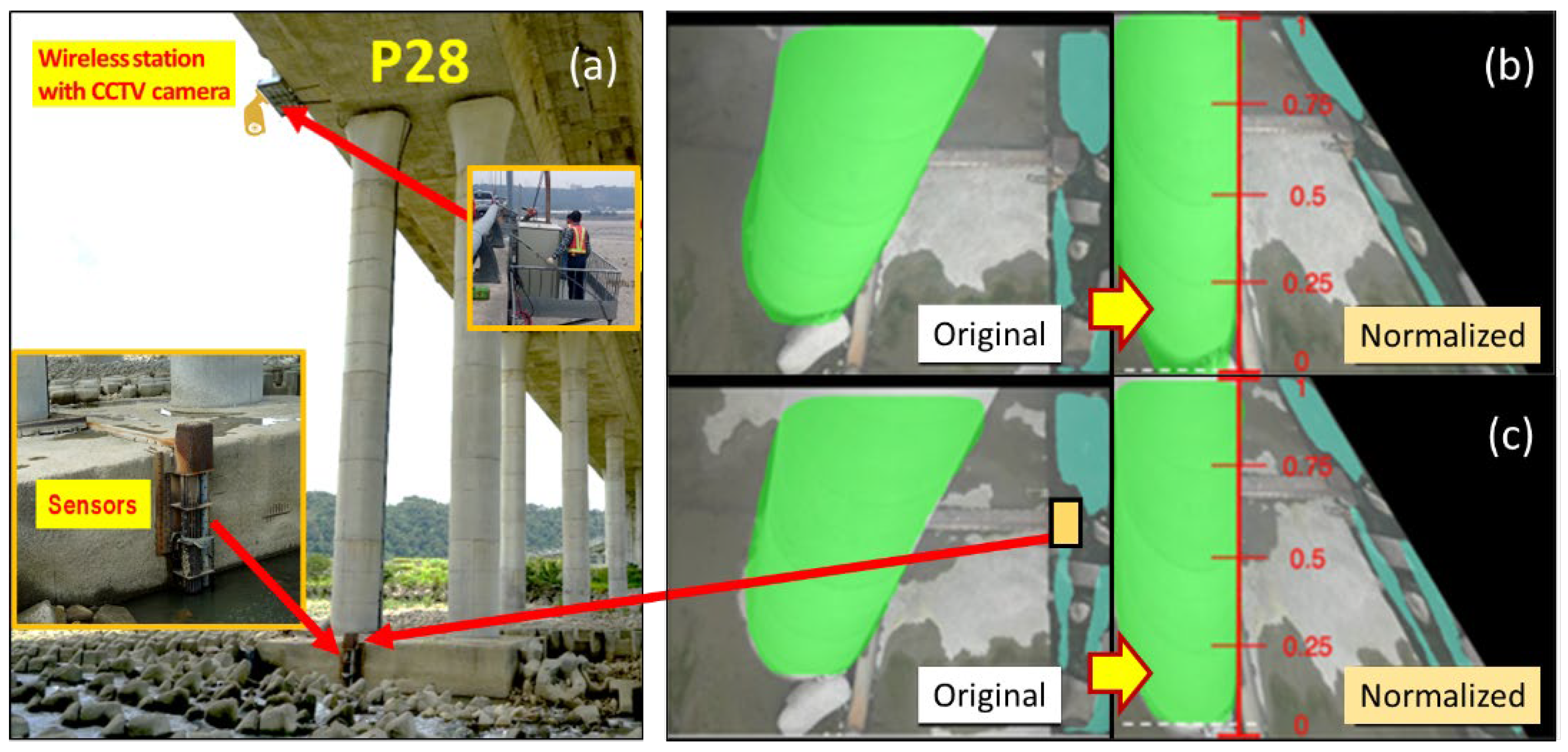
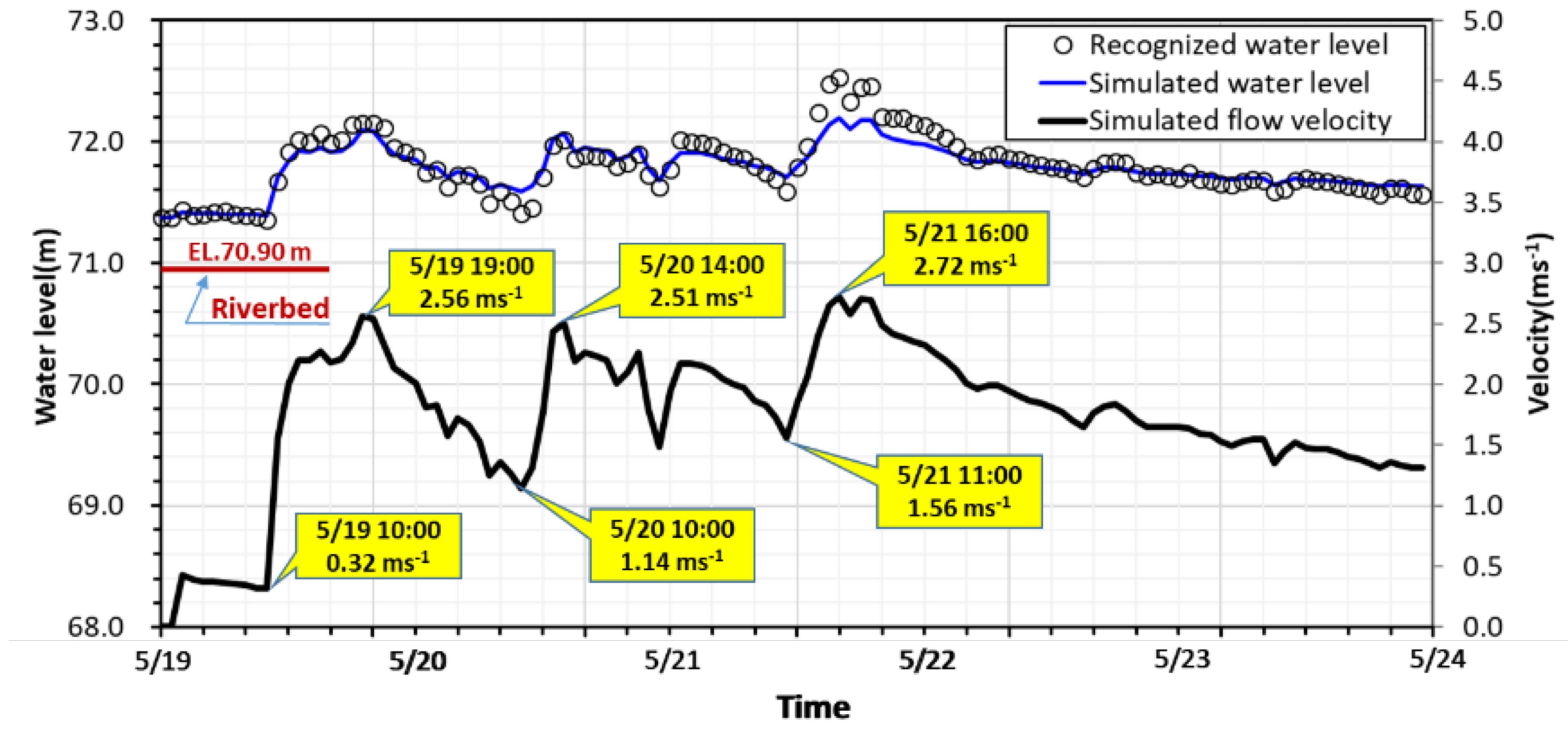

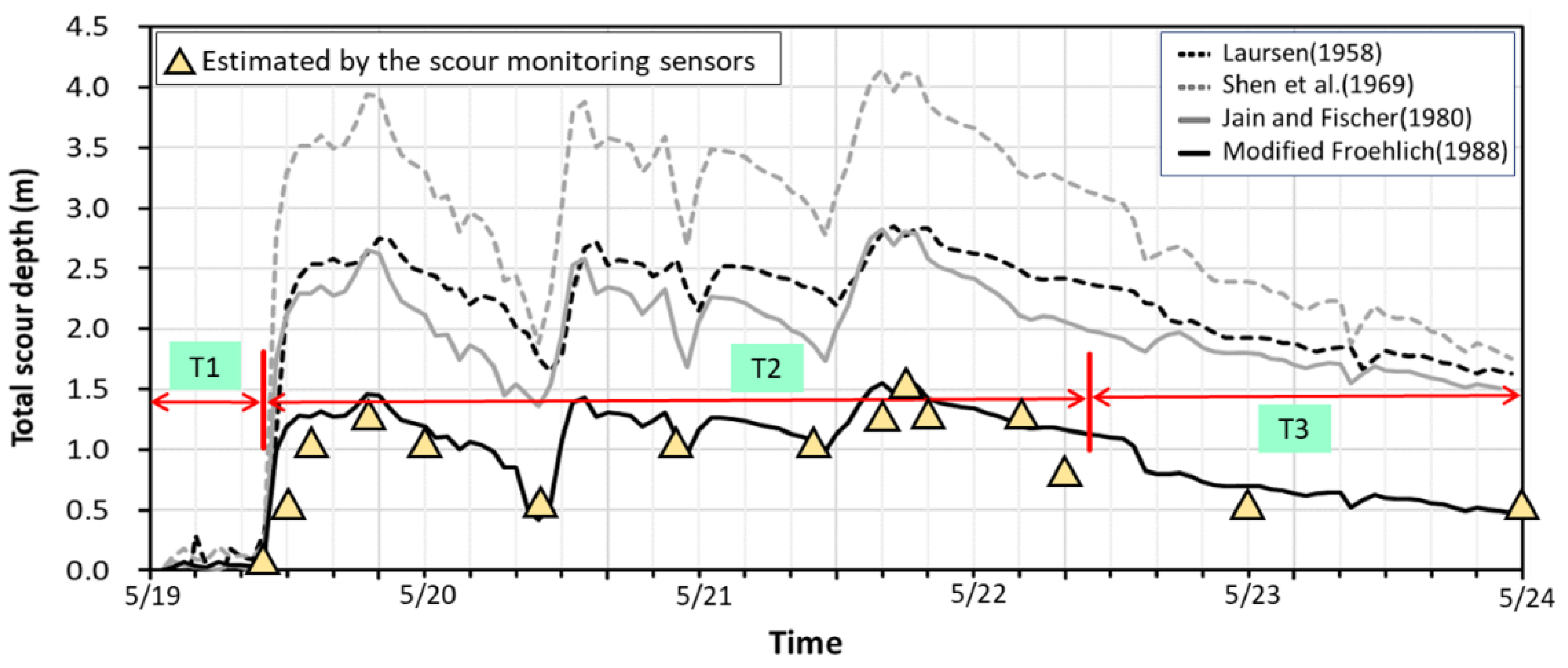
Publisher’s Note: MDPI stays neutral with regard to jurisdictional claims in published maps and institutional affiliations. |
© 2021 by the authors. Licensee MDPI, Basel, Switzerland. This article is an open access article distributed under the terms and conditions of the Creative Commons Attribution (CC BY) license (https://creativecommons.org/licenses/by/4.0/).
Share and Cite
Lin, Y.-B.; Lee, F.-Z.; Chang, K.-C.; Lai, J.-S.; Lo, S.-W.; Wu, J.-H.; Lin, T.-K. The Artificial Intelligence of Things Sensing System of Real-Time Bridge Scour Monitoring for Early Warning during Floods. Sensors 2021, 21, 4942. https://doi.org/10.3390/s21144942
Lin Y-B, Lee F-Z, Chang K-C, Lai J-S, Lo S-W, Wu J-H, Lin T-K. The Artificial Intelligence of Things Sensing System of Real-Time Bridge Scour Monitoring for Early Warning during Floods. Sensors. 2021; 21(14):4942. https://doi.org/10.3390/s21144942
Chicago/Turabian StyleLin, Yung-Bin, Fong-Zuo Lee, Kuo-Chun Chang, Jihn-Sung Lai, Shi-Wei Lo, Jyh-Horng Wu, and Tzu-Kang Lin. 2021. "The Artificial Intelligence of Things Sensing System of Real-Time Bridge Scour Monitoring for Early Warning during Floods" Sensors 21, no. 14: 4942. https://doi.org/10.3390/s21144942
APA StyleLin, Y.-B., Lee, F.-Z., Chang, K.-C., Lai, J.-S., Lo, S.-W., Wu, J.-H., & Lin, T.-K. (2021). The Artificial Intelligence of Things Sensing System of Real-Time Bridge Scour Monitoring for Early Warning during Floods. Sensors, 21(14), 4942. https://doi.org/10.3390/s21144942








